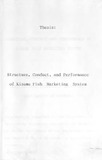| dc.contributor.author | Abila, RO | |
| dc.date.accessioned | 2013-05-10T05:52:23Z | |
| dc.date.available | 2013-05-10T05:52:23Z | |
| dc.date.issued | 1995-04 | |
| dc.identifier.citation | Abila, R. O(1995). Structure, conduct and performance of Kisumu fish marketing stystem | en |
| dc.identifier.uri | http://erepository.uonbi.ac.ke:8080/xmlui/handle/123456789/21022 | |
| dc.description | Msc- Thesis | en |
| dc.description.abstract | The study analyzed the structure. conduct and performance
of Kisumu fish marketing system. with the aim of understanding
the organi7ation of the market. the role of marketing mlddlemen.
their capital outlay. costs and returns and how these relate to
consumer price of fISh. The study also assessed sources of supply
of fish and the respective distribution channels.
Three areas of the fish marketing system were focused on.
First. the structure of the market was analv7ed in four aspects.
namely: market concentration. product differentiation. market
integration and conditions of entry into the fish business .
Market conduct was analysed by measuring the degree of conclusion
Among traders in making market decisions. Finally. market
performance was evaluated bv looking at the cost structures of
the various fish types sold in Kisumu and relating the traders'
gross margins to the consumer prices. the marketing margins and
the opportunity cost of the traders' entrepreneurship.
The studv used primary data obtained by interviewing 53
wholesalers and 98 retailers of different types of fish in Kisumu
metropolitan urban area in March to May 1991. A stratified random
sampling technique was used in selecting the sample whiIe data
was analyzed using SPSS and Harvard Graphics computer packages.
It was found that Lake Victoria and Lake Turkana supplied
the fish sold In Kisumu. The largest 9'% and 7% wholesalers
representing the largest 4 and 8 wholesale traders handled 30%
and 43% of the wholesale market sales. The same percentages of
retailers controlled 32% and 48% respect i vely of the retail
market sales. The wholesale market had a Gini coefficient of 0.37
while that of the retaiI market was 0.4% based on this. The
wholesale market has b e e n categorized as competitive and the
retail market as oligopolistic ,
There was product differentiation in the market and very
little formal vertical market intez ration . Instead the t r a d e r s
commonly established trade contracts to ensure reliable fish
supplies. The only notable barrier to entry into the fish trade
was lack of suitable market space for new traders. WhiIe traders
did not collude among themselves to decide fish prices or control
sales volumes, one aspect of collusion noted was among
wholesalers where by they were barred from serving consumers
directly, even where this was convenient.
The traders g:ross margins constituted between 17% and 42%
of the consumer price of the different fish types. The net
incomes to traders were higher than the traders' opportunity cost
for entrepreneurship, indicating that the incomes, hence gross
margins, were excessive. In conclusion, the fish market had
factors which favour imperfect competition. especially at the
retail level. The resulting market prices were inefficient since
they contained excessive trader remunerations and therefore did
not reflect the costs-of providing the marketing services. | en |
| dc.description.sponsorship | University of Nairobi | en |
| dc.language.iso | en | en |
| dc.subject | Fish | en |
| dc.subject | Marketing system | en |
| dc.title | Structure, conduct and performance of Kisumu fish marketing stystem | en |
| dc.type | Thesis | en |
| local.publisher | Department of Agricultural Economics, University of Nairobi, Kenya | en |

